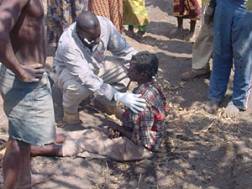The problem
For almost a century, Kabwe, a city of 300,000 in Zambia, has been highly contaminated with lead from a government-owned lead mine and smelter, Zambia Consolidated Copper Mines (ZCCM). Although the mine has been closed since 1994, residents continue to get sick and die from the contamination due to a lack of cleanup efforts on the part of the company and the government.Lead is one of the most potent neurotoxins known to humans. When breathed in, lead directly attacks the central nervous system. It is particularly damaging to infants and children, and can cross the mother's placenta, putting unborn and nursing infants at risk. Yet, remarkably, the citizens of Kabwe have until recently been completely unaware that they are living in one of the most poisoned cities on earth. Blacksmith founded a local NGO, Kabwe Environmental and Rehabilitation Foundation (KERF), that has been bringing educational services to the community on how to limit exposure to lead, and nursing support for those who are ill.
Health Impact
How can lead affect my health?Scientists use many tests to protect the public from harmful effects of toxic chemicals and to find ways for treating persons who have been harmed.
One way to learn whether a chemical will harm people is to determine how the body absorbs, uses, and releases the chemical. For some chemicals, animal testing may be necessary. Animal testing may also help identify health effects such as cancer or birth defects. Without laboratory animals, scientists would lose a basic method for getting information needed to make wise decisions that protect public health. Scientists have the responsibility to treat research animals with care and compassion. Scientists must comply with strict animal care guidelines because laws today protect the welfare of research animals.
The effects of lead are the same whether it enters the body through breathing or swallowing. The main target for lead toxicity is the nervous system, both in adults and children. Long-term exposure of adults to lead at work has resulted in decreased performance in some tests that measure functions of the nervous system. Lead exposure may also cause weakness in fingers, wrists, or ankles. Lead exposure also causes small increases in blood pressure, particularly in middle-aged and older people. Lead exposure may also cause anemia. At high levels of exposure, lead can severely damage the brain and kidneys in adults or children and ultimately cause death. In pregnant women, high levels of exposure to lead may cause miscarriage. High-level exposure in men can damage the organs responsible for sperm production.
Current Activity
As a result of Blacksmith's involvement, the World Bank and the government of Zambia have taken notice of this human health tragedy. In 2003, the World Bank approved a $15 million grant and loan to clean up this city as part of the larger Zambian Copperbelt Environment Project (CEP). This was an extraordinary result for Blacksmith, and demonstrates that Blacksmith's initiatives can be leveraged to enable very large contributions from major global institutions for remediation and infrastructure. KERF is currently building a community health and education center to combat lead poisoning.Future Plans: KERF is educating the community about the lethal environment in which they live. This is helping to create the leverage necessary to force the Zambian government into adopting an acceptable environmental remediation plan. Blacksmith's work has resulted in $15 million to be set aside for Kabwe's lead clean-up, and these funds now need to be spent effectively, and with full community oversight.
A community center is being built in Katondo, with plans for future Centers in Chowa, Kasanda and Makululu. The community cannot be helped unless they understand fully the issues that impact their lives. KERF's environmental education programs have helped the residents of Kabwe's communities to understand the issues of lead and make good decisions about how to avoid and clean up contamination.
KERF will begin to develop plans and capacities for alternative communication strategies through the Centers such as the use of a radio station and distribution of one channel wind-up handsets. KERF will eventually provide the required programming and technical training that will enable the community to run the system successfully. Improved communications capacities would enable the KERF to reach a much wider audience quickly and with minimal resources. KERF will also begin to develop alternative income strategies for groups and scavengers that work in highly contaminated areas such as the dumps sites, helping to provide economic incentives for affected families to move them away from the most toxic areas.
The World Bank and ZCCM are currently undertaking plans to dredge a polluted canal flowing past the settlement of Katondo which regularly floods and distributes contaminated sediment near homes.
Data File
Pollutants:
Lead
Location:
Kabwe,
Zambia
Transmission:
air, direct contact, trophic accumulation
Source:
Mining, Smelting
Potentially affected people:
300,000
Report Type:
Project
Project Status:
Ongoing Project
Pollution Status:
Legacy


